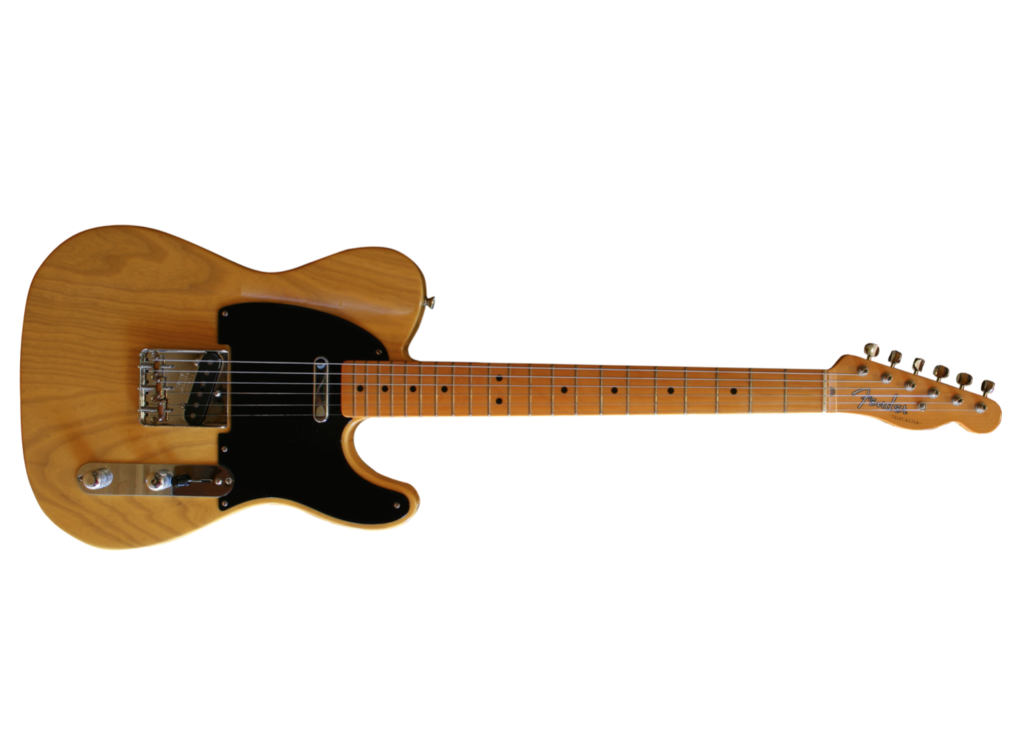10 Guitars You Need to Know #1: Fender Telecaster
Author: Lucas Frost

Table of Contents
1. The Innovator: Fender Telecaster
The Fender Telecaster revolutionized traditional guitar making
With its simple, no-frills design, and unashamedly mass-produced, the Telecaster may seem unspectacular today. But when it was first released in 1950, its impact was revolutionary. By cleverly re-thinking every aspect of traditional guitar making to suit the mass-production age, Leo Fender was offering a great-sounding guitar that anyone could afford.
Guitars featuring electromagnetic pickups had been around since around 1932 – companies like Rickenbacker and Gibson were carefully crafting instruments using old-school methods, carving each guitar individually out of precious, exotic woods such as mahogany and ebony. These were beautiful, (hollow-body) acoustic guitars, where the pickup served purely to make it audible over the horns and drums of the big-bands popular at the time. And making them was slow, laborious work, turning them in expensive tools for the professional musician. The Fender Telecaster was about to start the revolution…
Designed for the Masses
(This is the nerdy bit.) The Telecaster was designed primarily with production methods in mind. For a start, Fender started using native woods such as Ash, Alder and Maple for its guitars, which were cheaper and readily available. Its solid body not only made it simpler to produce out of a single slab of wood, and greatly reduced feedback problems (the “screech” sound). The cavities for the electronics and the neck-pocket were routed in mechanically, sending the bod
y to be painted immediately after.
Fender Lowered production costs without compromising quality
The original Tele eliminated the need for a separate fretboard by making necks entirely out of Maple, which is hard enough to withstand the abrasive effect of the metal strings. A “straight” headstock meant that the neck could be made out of a single piece of wood – all this reduced production costs, and inadvertently added the brightness and clarity to the sound that Fender became known for subsequently. (Necks had been made of Mahogany, whose larger cell-structure reduce some of the higher over-tones). And instead of glueing the neck to the body, as was common, Fender bolted it securely in place – saving time and facilitating repair work.
Greg Koch demonstrates the Fender Telecaster
The bridge, which attaches the strings to the body, was equally genius in its simplicity: a steel bridge-plate with three, separately adjustable bridge-saddles. The steel place “shielded” the pickup from electromagnetic interference, while the saddles could be moved to optimize the string’s intonation. Lastly, the Teleca
ster had a larger pickguard, onto which the pickups could be pre-assembled; similarly, the electronics were mounted onto a control board which was then easily screwed onto the body.
Furthermore, the Telecaster’s tonal characteristics were excellent! The combination of Ash and Maple gave a crisp sound, the solid body accentuated brightness, while the longer scale-length and slanted bridge pickup also favor the higher frequencies. Two pickups also gave guitarists a choice: the classic Telecaster Twang on the bridge pickup, or warmer, bluesier tones on the neck pickup.
Associated with some of our favorite guitar heroes
The Fender Telecaster was cheap, but with tons of character. It was endorsed by Muddy Waters and adopted by James Burton (who played with Elvis Presley); soon Keith Richards, Eric Clapton and Jimmy Page were playing Telecasters all over London. it remains one of the great guitars to this day, mainly associated with more earthy-sounding genres like Punk-Rock, but also seen in Blues and Country. All this thanks to its avant-garde industrial design, which reduced production costs enormously without compromising quality.
My next installment takes a closer look at the Gibson Les Paul. Did you know that this guitar was initially unpopular? Find out how the LP became the monster of Rock ‘n’ Roll.








Most def one of the greatest guitars of all time. it has a sound all its own. That tele twang. So awesome for country, rock, and Blues. really every genre of music has been played on a Tele. It just a simple, plain, Masterpiece…….
The Telecaster is my favorite guitar ever! It is super versatile but what I love most about the tele is its body. The telecaster body fits my body like a glove and feels amazing.